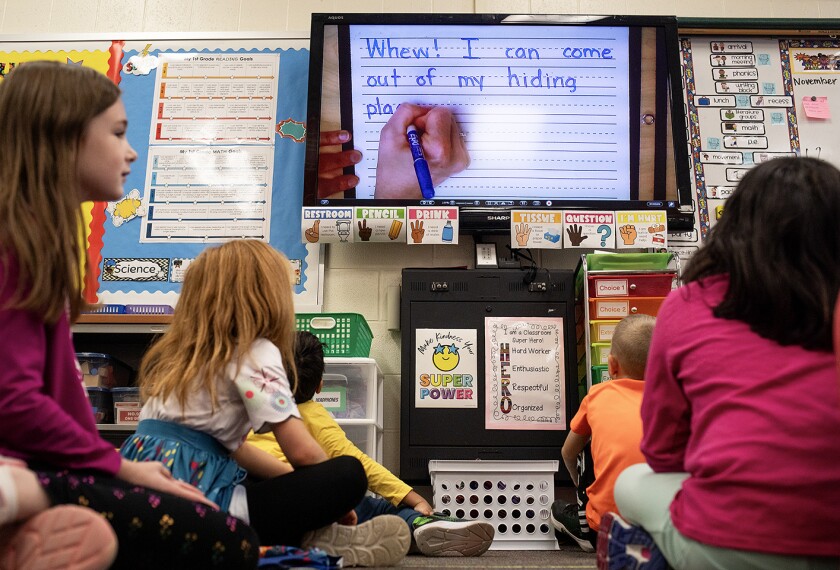A multitiered system of supports for students is a model with a lot of moving parts and cooperation needed at every level, from the classroom to the state education agency. As a study of Michigan’s statewide MTSS initiative found, “initial implementation is fragile, and sustained support must be provided to expect sustained implementation.”
Problems can arise at any level of the system, from the core instruction for all students at Tier 1, to Tier 2 interventions for students falling behind, to the intensive services provided for students at Tier 3. Here’s how Ingham Intermediate school district—a regional agency serving 12 local districts and 10 charter schools—broke out the costs and common challenges at every phase of its multitiered system of supports model for academic and behavioral improvement.
Shared Leadership
What it is: Building consensus among critical leaders and staff members and setting up infrastructure to begin a multitiered system of supports in a new school.
Annual cost per student: $1.59 for the first three years; no ongoing cost.
Challenges: Ingham won early buy-in from school and district leaders for its mutltitiered-supports initiative in 2009 with $11 million in start-up funding from the federal stimulus package. But principal and superintendent turnover has led to uneven support from school to school and district to district. Districts have suspended implementation for a few years at a time when leaders were not interested or did not understand the model.
Universal Screening
What it is: Assessing all students’ academic and behavioral status, both initially and at regular times during the school year. This includes literacy and math screening for all students in K-8 and for 9-12 students previously identified as at risk of falling behind academically, as well as behavior evaluations for all K-12 students.
Annual cost per student: $7.50 for the first three years; $7.75 ongoing.
Challenges: Setup includes both the buying the tests themselves and training teachers and staff to use them, and in Ingham, training and winning buy-in from staff was the bigger hurdle. “Screening was a battle in the beginning,” said Laura Colligan, Ingham’s supervisor for student instructional services. “People were worried we would be tracking kids. You always heard one horror story of [someone who heard] some child was put in a special [education] program based on” one assessment screener.
Progress Monitoring
What it is: Using formative assessments, observations, and other data to track students’ progress and gauge whether a particular intervention is helping them.
Annual cost per student: $5.50 for the first three years; 55 cents ongoing.
Challenges: “We had to look at how we used our personnel resources,” said Lisa Francisco, the principal of Alaiedon Elementary School in the Mason, Mich., school district (part of Ingham). “We use paraprofessionals a lot more instructionally than they were before, in progress monitoring. They needed training. We brought them into planning. ... They are very stressed right now, but they are far more valuable there.”
Monitoring individual students has also led to tough conversations about teachers’ expectations for particular groups of students. “Sometimes, there were kids who were not put in Tier 3,” as teachers requested, “because the teachers had not shown that they were really accessing the [Tier 1] core curriculum,” said Pamela Westfall, an interventionist at Elliott Elementary School, part of the Holt public school system.
Data-Based Decisionmaking and Problem-Solving
What it is: Collecting, analyzing, and summarizing students’ data, alone or in a group, to answer questions and match students with appropriate instruction and interventions.
Annual cost per student: $9.60 for the first three years; 96 cents ongoing.
Challenges: “One of our mistakes was just bringing together data on everything,” said Helen McNamara, Ingham’s assistant superintendent for budget and financing. “It was too much data; people got overwhelmed, and we never really had time to say what is the ‘so what?’ of this data. Now, [school] teams meet and talk about one or two things. You have math, reading, behavior: Just focus on your weakest area and start unpacking that.”
Research-Based Instruction, Intervention, and Practices
What it is: Using programs and practices—in core instruction and for interventions—that have reliable scientific evidence of being effective with the students who are using them.
Annual cost per student: The core curriculum cost $100-$120 for reading and $85-$100 for math. Interventions ranged considerably, from $12 to $710.
Challenges: Ingham got some pushback against uniform curricula: “Many of our districts had no core reading curriculum when we started, and only one had a research-based one,” McNamara said. “Now, 11 out of 12 do.”
Ingham also constantly works to provide a big enough pool of evidence-based interventions for every subject and grade level, with high school interventions particularly scarce.
Student and Family Involvement
What it is: Providing online and in-person training for parents to understand the multitiered system and to support and monitor their students’ progress at home.
Annual cost per student: $3.63 for the first three years; no ongoing costs.
Challenges: “You have to make sure you have a lot of consensus, but we didn’t get a lot of training on how you build that consensus,” Francisco said. “How do you hear the voices of the naysayers, help them know they’ve been heard and yet that we are still moving forward?”





